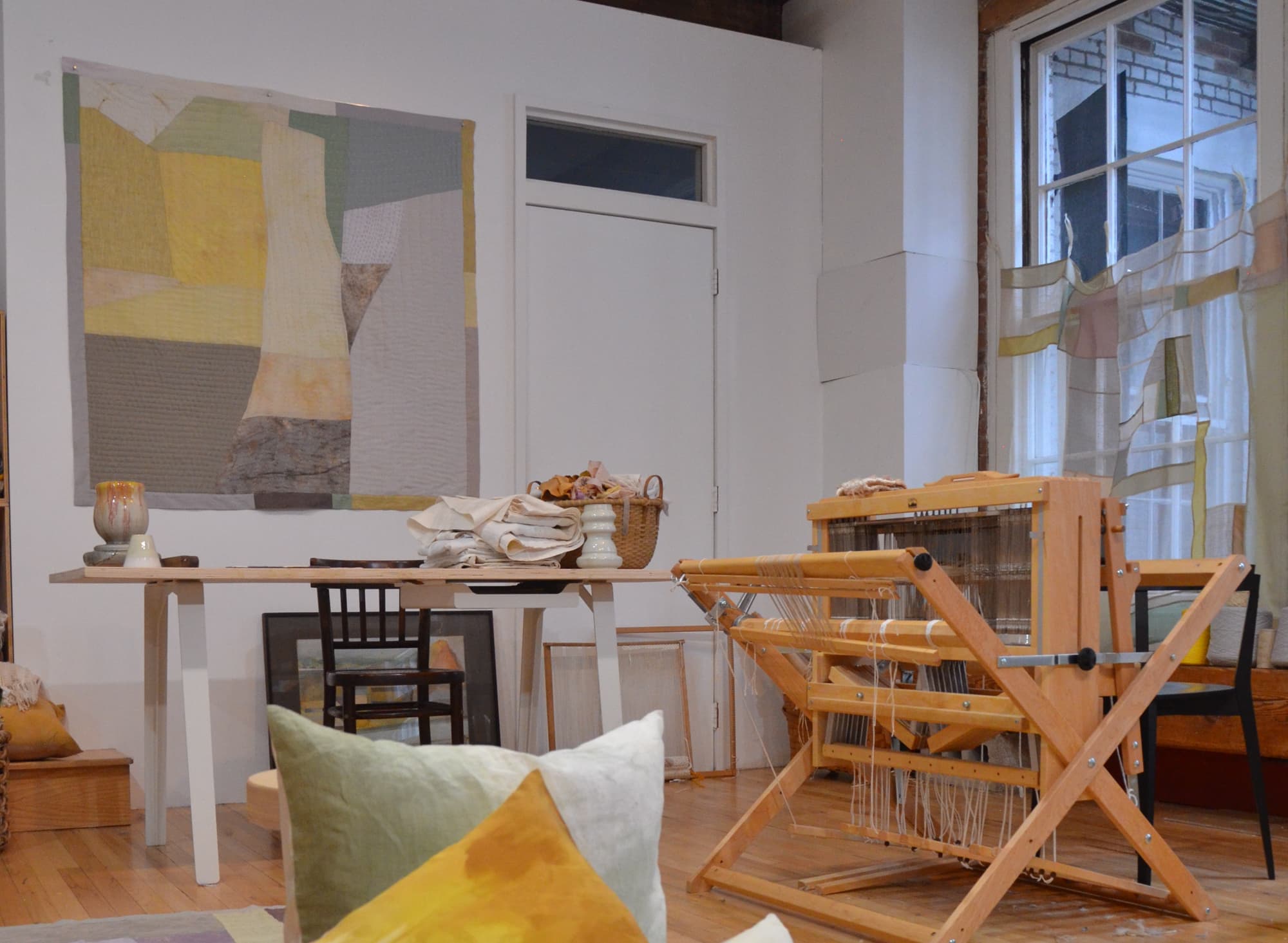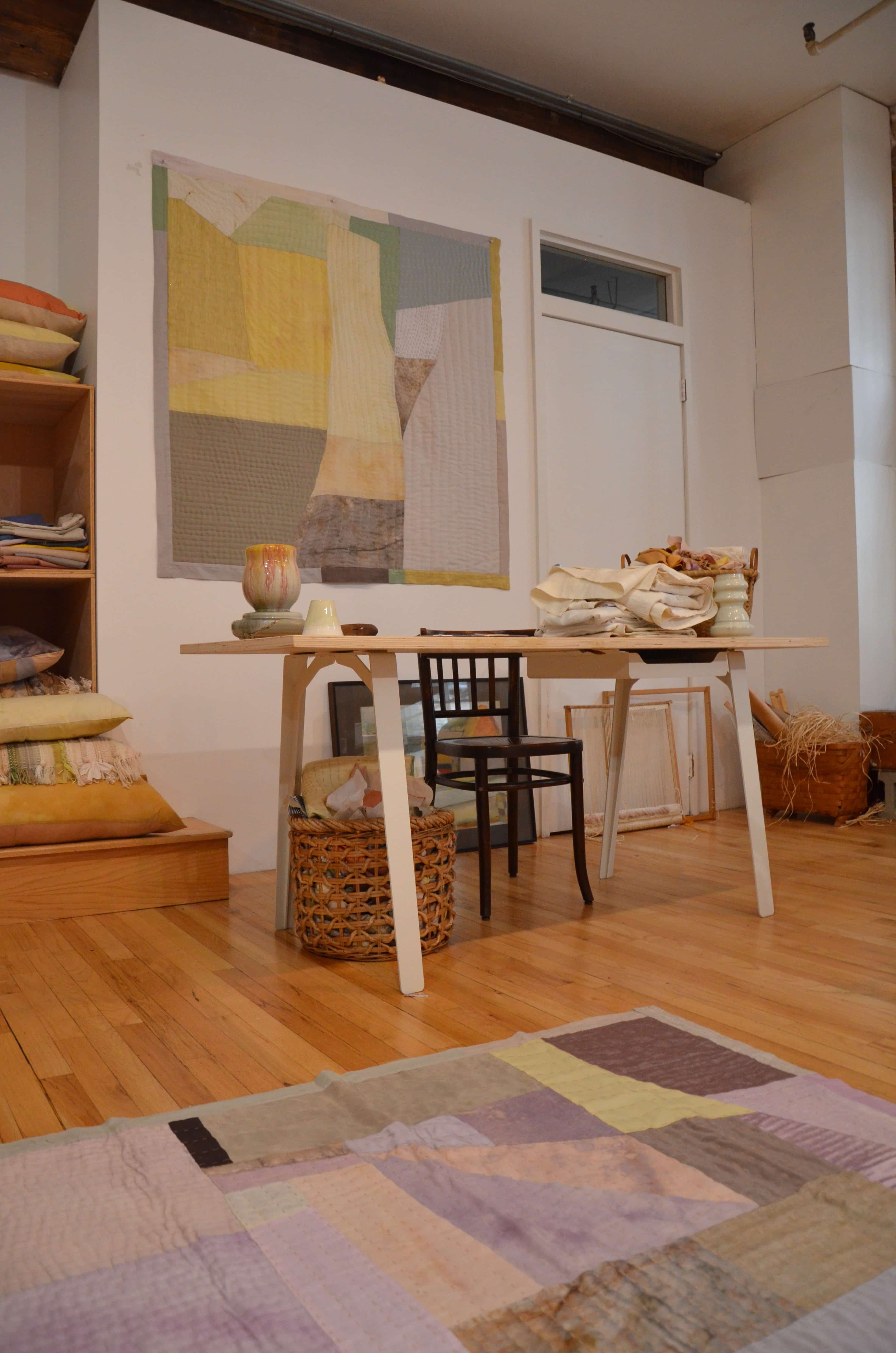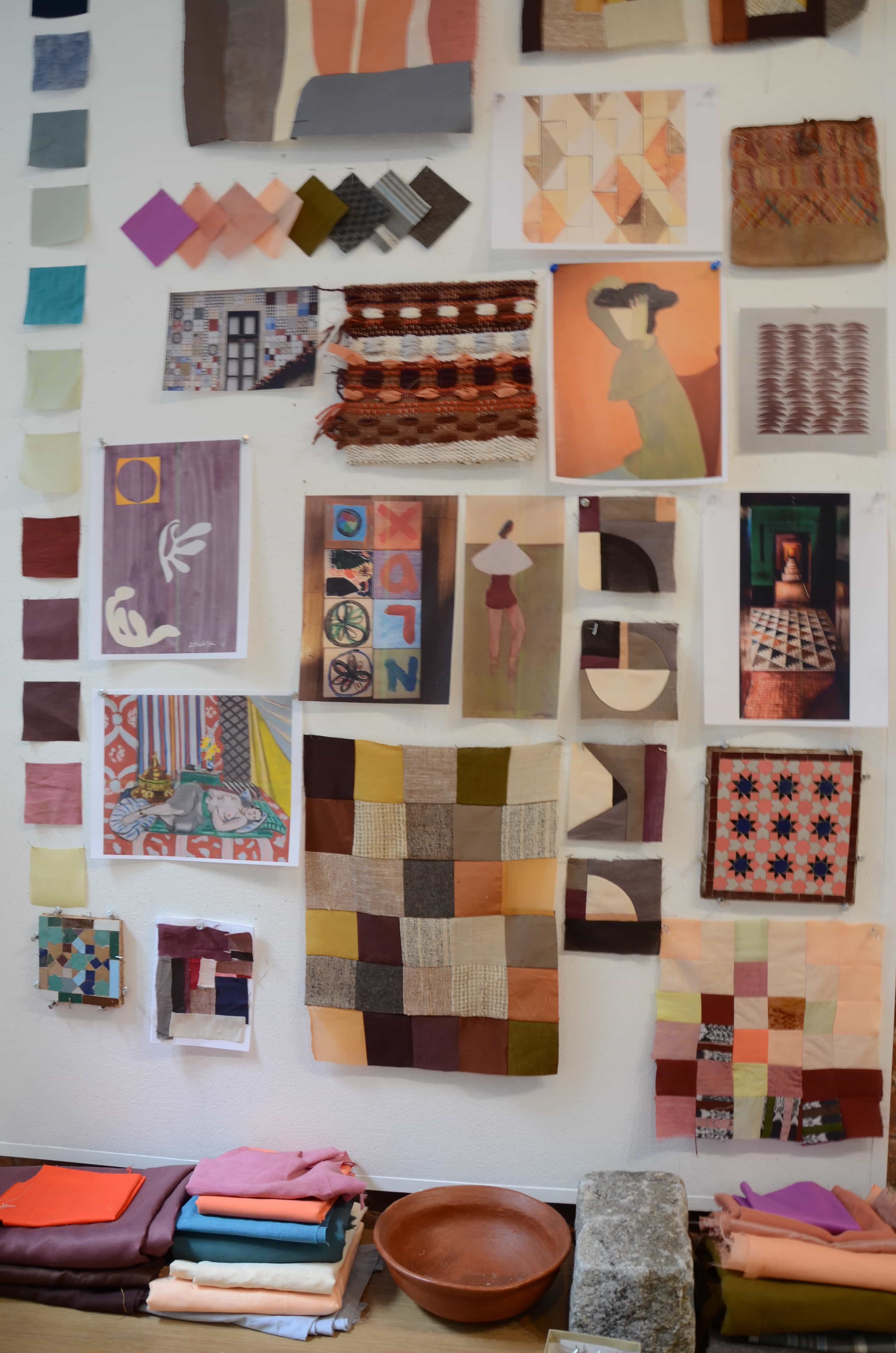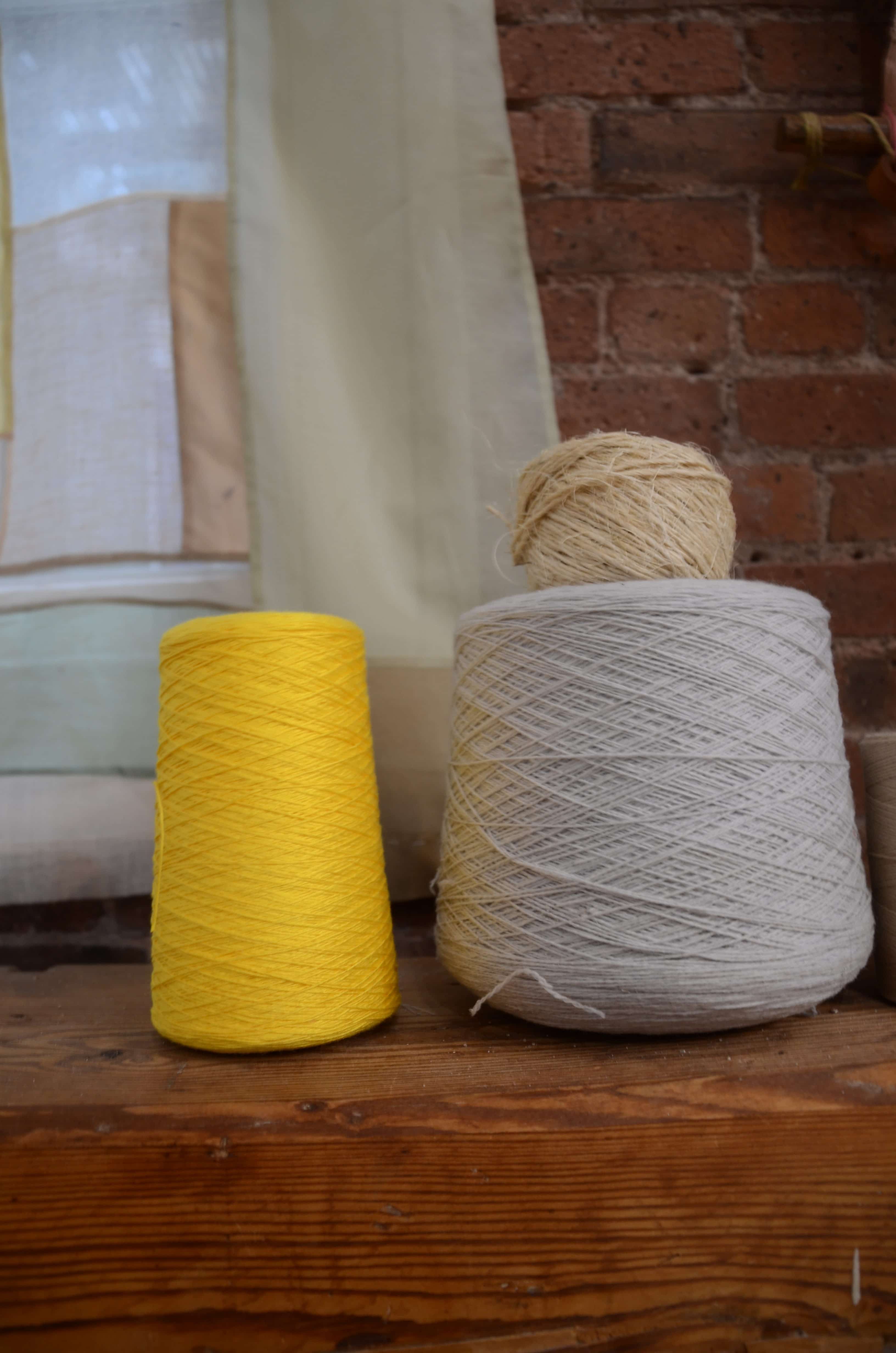A craftsperson with the spirit of an artist — Kiva Motnyk's textile practice blends technical prowess with an openness and curiosity borne from years of collaboration and experimentation. It's this interplay — her subtle use of colors and textures with a wabi-sabi embrace of the natural beauty in imperfection — which has become something of a signature. Working out of Thompson Street Studio (formerly her family home and, now, a space that functions as a sort of New York City sanctuary for textile arts), Kiva sells her work worldwide and regularly hosts exhibitions, shows, and workshops.
Contributor Benedicte Lux recently visited Kiva at Thompson Street Studio to ask more about her philosophy, process, and inspirations

THE KINDCRAFT
Tell us about your background...
Kiva Motnyk
I grew up between NYC and San Francisco. I studied Fashion Design — and then Textile Design — at RISD. I then came back to NY and worked for Susan Cianciolo, Calvin Klein, Isaac Mizrahi, to name a few. I was helping with a wide range of design tasks, primarily focused on creating the concepts, inspiration direction, and textile stories for the collections.
I also had an opportunity — rare in this industry — to work closely with the textiles: Painting fabrics for Isaac’s couture collections, or weaving and sewing for Susan’s handmade collections. As time went on and I grew into creative director roles, I felt farther removed from the tactile process — and I missed working with my hands directly with the materials. That's when I decided to start the studio.







THE KINDCRAFT
Thompson Street Studio used to be your family home?
Kiva Motnyk
This is my family space, the space I grew up in — which was also my parent’s art studio. My father was a painter; My mother, a dancer. It felt very open and creative with lots of energy. There was little separation of their work and home/family life and, because of that, it felt very open, shared and communal. Growing up, there was lots of shared creativity at home which I was exposed to.
THE KINDCRAFT
How long have you been running TSS? What were you doing before this?
Kiva Motnyk
I opened Thompson Street Studio in December 2014, so about 3 years ago. Before that, I worked as a textile designer and creative director.
THE KINDCRAFT
Can we talk about your choice to start this slow, artisanally-focused studio in New York City?
Kiva Motnyk
New York is my home; I was born here and grew up here so I never considered working any other place.
THE KINDCRAFT
What is the relevance of producing textiles of authenticity?
Kiva Motnyk
It's a way of life, I never considered working in any other way. The objects I value in my home are things that have a story or meaning in some way to me — whether it is a painting given to me by my father, a wood box carved by my husband, or a textile I found while traveling. Those things are made with intention or have an important story. I want to make things that have this importance and lasting value.







THE KINDCRAFT
What's your daily routine like?
Kiva Motnyk
I usually start the day having a cup of tea and a short meditation, then I take my dog Sammie for a walk. I love my morning routine because it grounds me to start my day with intention and focus. When the day starts in the studio, it’s a range of projects that take place and there is no set routine. Sometimes I'm in meetings or working on production. I'm dyeing fabrics, working on commissioned projects, setting up installations or presentations, and traveling. The days are very busy and I value my creative time.
THE KINDCRAFT
Do you outsource anything — or is everything made in studio?
Kiva Motnyk
Much of what I make is done in the studio. Some things are made with collaborators and artisans outside the studio. Collaboration is a very important part of the process. I'm also very interested in traveling and learning about traditional textile techniques and I plan to work more with master artisans from around the world.
THE KINDCRAFT
Talk me through your year-long collections...
Kiva Motnyk
The year-long process starts with experiments in the studio, usually sewing swatches or paintings or sketches. I like to spend time in the country and I get a lot of inspiration from nature, materials, and colors I find. I'll usually create a palette using natural dyes to start with. I think this is a helpful way for me to start and it's therapeutic to create the colors from nature with the materials I forage for.

THE KINDCRAFT
What is the relevance of time in your practice here at the studio? Why are you “taking so long” when everything else is speeding up?
Kiva Motnyk
I enjoy the process of creating the collections. For me, it’s so much about the journey. Each collection has a different process and dialogue.
THE KINDCRAFT
Can we talk about scale? About the choice to work on something for so long, invest so much into the process, and produce small editions?
Kiva Motnyk
Many pieces are one-of-a-kind, while others I offer small runs of production on. My goal is quality and, if I have to compromise on this to make large quantities, then that doesn't work.
THE KINDCRAFT
How do you use inspiration and what is your process? Is this a process of research and then translating that to object/texture/feel?
Kiva Motnyk
I've been traveling lately and the last trip was to Portugal and Morocco. I inevitably come back with lots of inspiration that will be incorporated into the collection. My constant inspirations, though, are deep-rooted and I see repeated ideas, inspired by nature, mixed with the influences of growing up in a city.
It’s also being diligent in your practice. I wake up every day and work. Sometimes I am unhappy with what I am making but, if I keep at it, eventually it evolves to something I’m happy with.







THE KINDCRAFT
You also have a farm upstate where you grow natural dyes and host workshops. How did that come about? What do you grow there?
Kiva Motnyk
I've always lived in the city, so spending time in the country, for me, is very special. I used to go to the country every weekend with my husband and, eventually, we decided to buy a place in the Catskill Mountains.
I do most of my natural dyeing there and have a garden that I grow specific plants that I use — but often I forage for local plants, which is my favorite way to find ingredients. I use foraged evergreen trees, weeds such as goldenrod, blueberry, blackberry, marigold, wildflowers, and woods like maple, and sumac. Each season is a different range or plants and colors. I have hosted workshops as well, which is so nice to bring people together in my favorite place to experiment with a range of plants and work outside.
THE KINDCRAFT
Can you talk about the relevance of both collaborations and teaching to your own practice?
Kiva Motnyk
Collaborating has always been a way of working that I enjoy and comes very naturally. My collaborations have been a very organic process and the relationships develop naturally. I enjoy working with people who have different perspectives. It’s about a dialogue and you do have to be very open to what all the possibilities and outcomes are. My work with Susan Cianciolo started when I first graduated from collage and I worked as her assistant. We have continued to work together in different ways for the last 15 years.
Workshops are another natural way for me to include others in the process and to communicate and to share an experience.
THE KINDCRAFT
Can you talk about Yalo Run and craft in the U.S.?
Kiva Motnyk
Yalo Run is a special space based in Mississippi founded along with Coulter Fussell and Susan Cianciolo. It's a space created with the intention of hosting classes and workshops to teach the American traditional technique of quilting, along with other textile techniques. It's been an honor to have an opportunity to help support an American traditional art-form in a part of the country that has a great value for it and to help share a skill that traditionally has been passed down through generations in families.
THE KINDCRAFT
I'm always drawn to the intersection of art, craft and fashion. Fashion is more of a craft than art, but art can also be “craft”. I dislike making distinctions as I see them interchangeably in many ways – but how do you see this and your own place within the “industries” of fashion and art?
Kiva Motnyk
I think this is something I continue to explore, this distinction between what is considered "art" or "craft" and "design". I feel it’s a blurred line for me. Ultimately, I think making art has to do with creating something with integrity and inspiring emotion.
THE KINDCRAFT
What's the future of Thompson Street Studio? How do you see it evolving?
Kiva Motnyk
The future of TSS will be to continue to explore new mediums. We will launch a few pieces of clothing for spring and continue to incorporate furniture inspired pieces expanding into the three dimensions.







